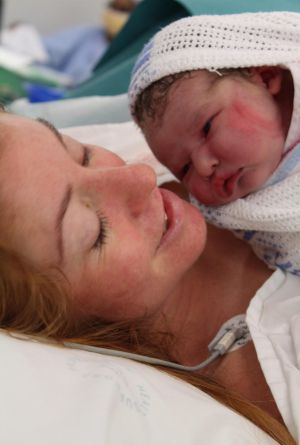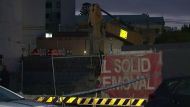Amy Dawes was hell bent on having a natural birth. Twelve hours into her labour, and consumed by pain, the 32-year-old was wheeled into an operating room.
Her options had depleted: caesarean or forceps.
More News Videos
Childbirth without the 'trauma'
Western Sydney University has been running trials of an antenatal course that focuses on pain relief techniques, resulting in a 44 per cent lower rate of caesarean births.
"I knew nothing about forceps. I thought it sounded scary … but after all the research I'd done I'd come to the conclusion that caesareans were pretty bad and rough for the baby," the Brisbane mother said.
The doctor opted for the forceps.

Her baby was delivered and whisked out of the room, leaving Ms Dawes on the operating table as the blood began to pool.
"I remember shaking on the operating table, I don't know if it was the adrenalin or fear but I thought I was going to die."
It was a third-degree perineal tear. But her daughter Eliya would be 16 months old before Amy realised the true extent of the damage done.
"That was when the bottom fell from my world," she said.

Her pelvic floor muscle had torn completely off her pubic bone. She was diagnosed with a bilateral levator avulsion causing a stage two bladder and bowel prolapse.
"I was broken. I felt like an 80-year-old in a 35-year-old's body.
"I couldn't lift my daughter when she cried or run after her. There are techniques to get out of bed, and I couldn't do the fitness training I was so passionate about," she said.
Ms Dawes said she wanted to avoid a caesarean. She had been well-informed of the risks of the surgery. But at no time was she told of the potential harms of forceps delivery.
"That's what's so hard to get my head around: your body can be damaged beyond repair without being informed of the risks. How did I not know about this?" she said.
There are growing concerns that women are not being told of the potential trauma of vaginal births, as a concerted push the cut the rates of caesarean sections could be pressuring clinicians to attempt riskier vaginal deliveries.
The warning strikes at the centre of a fierce debate over a woman's autonomy in childbirth amid an inexorable increase in the use of medical interventions and a powerful push back from the natural birth movement.
NSW Health's landmark Towards Normal Birth policy aimed to reduce caesarean section to lift the vaginal birth rate to 80 per cent by 2015.
Five years after the policy was introduced the state's vaginal birth rate has instead dropped by 1.7 per cent to 56 per cent since 2010, shows data published on HealthStats NSW on Friday.
The rate of elective caesareans has increased (17.7 per cent to 19.8 per cent) and the rate of emergency caesareans has not budged since 2010.
But the decline in vaginal births has slowed since the policy was enacted. The "natural" birth rate worsened by 7.7 per cent over the preceding 10 years. And the rate of vaginal births has remained stable at Sydney's largest public birthing hospitals, compared to the relentless downward march in private facilities.
NSW Health's Senior clinical adviser for obstetrics Professor Michael Nicholl said the 80 per cent figure was not a hard target, but "stretch goals to inform the system what is potentially possible".
"It's about reducing the rate of unnecessary intervention. I think in this discussion people often leave that word 'unnecessary' out," Dr Nicholl said.
"There was no doubt caesareans were life-saving," he said. "It's about reducing those instances where there may be another way of dealing with the clinical scenario."
"Women who are accessing maternity services need to have the best information regarding birth irrespective of mode and that discussion needs to be very balanced," he said.
But cutting the caesarean births rate was a counterproductive – even dangerous – goal when the primary objective was a safe birth for mother and child, said Professor of Obstetrics and Gynaecology at the University of Sydney and Nepean Hospital, Hans Peter Dietz.
"I was trained during a time when forceps were thought to be barbaric and obsolete. But they've been coming back and I'm seeing the casualties," Dr Dietz said.
The risk of major trauma for normal vaginal delivery or with vacuum was 10 to 20 per cent, Professor Dietz said drawing on international research consistent with his own Sydney-based data.
That increased to 30-65 per cent with the use of forceps.
Women can be left with severe pelvic floor trauma and trauma to the anal sphincter resulting in urinary and fecal incontinence, pelvic organ prolapse, debilitating pain and psychological damage.
For some patients the damage caused by their labour manifests years, even decades later.
"Every week I see at least two or three women who have had their lives permanently altered by what happened to them in the labour ward. And nobody told them," Dr Dietz said.
"We need to start treating our patients like adults. We need to tell them what the risks and make sure they understand exactly what they're letting themselves in for. This is not happening," he said.
Encouragingly, the use of forceps at three of Sydney's biggest public birthing hospitals with highest rates may have begun to plateau after peaking in 2014.
Forceps delivery dipped below 10 per cent of all births at the Royal Hospital for Women in 2015. Royal Prince Alfred Hospital's forceps rate dropped to 8 per cent, and Royal North Shore reduced its use of forceps to 11.3 per cent.
Ms Dawes is now 30 weeks pregnant with her second child.
"I have a booklet with information about forceps delivery and how it's of minimal risk to the baby. There [is] no information about the risk to the mother," she said.
"How are we meant to know if no one tells us?"










47 comments
New User? Sign up